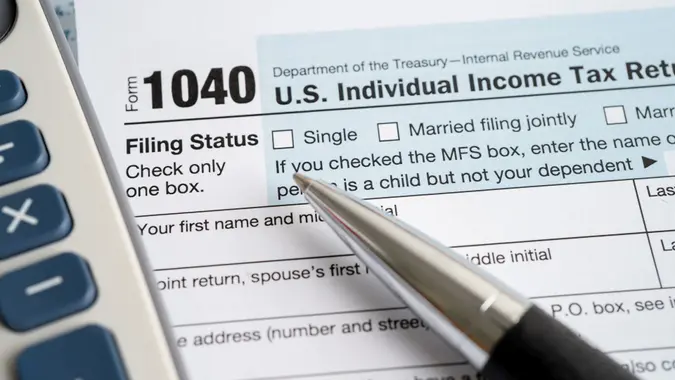I’m an Enrolled Agent: Make 4 Tax Moves To Reduce Your Tax Liability

Commitment to Our Readers
GOBankingRates' editorial team is committed to bringing you unbiased reviews and information. We use data-driven methodologies to evaluate financial products and services - our reviews and ratings are not influenced by advertisers. You can read more about our editorial guidelines and our products and services review methodology.

20 Years
Helping You Live Richer

Reviewed
by Experts

Trusted by
Millions of Readers
What comes to mind when you think about filing taxes? Apart from saving the date on upcoming filing deadlines, you may wonder what you can do right now to increase your tax refund.
What if there’s nothing you can do for a bigger tax refund? Try not to silently panic if you just read this sentence, as it’s meant to encourage taxpayers to change their thinking. GOBankingRates spoke to Christopher Jervis, enrolled agent and president of Lone Wolf Financial Services LLC, about why taxpayers should try to reduce their tax liability.
Why Shouldn’t I Try To Increase My Tax Refund?
Before listing out strategies to reduce one’s tax liability, here’s a step back to the topic of opting for a smaller tax refund, or even none at all. Why is it a bad thing to try to increase your refund?
“A tax refund is just your change from paying your tax bill,” said Jervis. “If you are getting larger and larger refunds, that means you are paying more than you need to.”
At the basic level, Jervis said those who paid too much in taxes get back the overage as their change. This is typically done by making estimated tax payments or by having the taxes held out of each paycheck. Those who didn’t pay enough in taxes owe the difference.
“We encourage taxpayers to get as close to zero as possible, with no large refund and no large balance due,” said Jervis.
Tips for Reducing Tax Liability
Now that you understand what a tax refund is and why it’s important to keep a tax bill as low as possible, follow these helpful strategies to reduce your tax liability.
Fund a Traditional IRA
If you qualify, Jervis recommends funding a traditional IRA by April 15, 2024. Those who do so can take the deduction on their 2023 taxes. Jervis said you can even file before funding the account and use the refund, which includes this deduction, to fund the IRA.
Keep in mind, however, that to save money, you’ll need to spend your own money.
“If you make a $6,000 contribution to your traditional IRA, you might receive an additional $1,320 in your refund, assuming a 22% tax bracket,” said Jervis. “But you must spend $6,000 out of your pocket to increase that refund by $1,320; you have $4,680 less in spendable cash than you did before.”
Take Advantage of Your Employer’s Pre-Tax Benefits
Some of these may include a 401(k) plan and a Health Savings Account (HSA), which can reduce the amount of income that is subject to tax.
Take Advantage of Deductions and Credits
Here’s how each term is defined:
- Deductions: This reduces how much income you must pay tax on.
- Credits: Jervis said these come in two types, including non-refundable credits and refundable credits. Non-refundable credits reduce your tax bill but cannot reduce it below zero, while refundable credits reduce the tax bill and generate a refund back to the taxpayer of any unused portion.
Jervis said common credits include the Child Tax Credit, the Dependent Care Credit for child care, the Other Dependent Credit for older children or dependents that aren’t directly related, and the Earned Income Credit for lower income taxpayers.
Work With a Tax Professional Year-Round
Jervis recommends taxpayers find a proactive tax professional with whom they can work with all year. Options become much more limited — and expensive — once the year closes.
Ideally, Jervis said taxpayers should also meet with this tax pro once or twice a year aside from the time when they prepare taxes. Doing so allows them to better project how things will look in the next year.
 Written by
Written by  Edited by
Edited by 

























